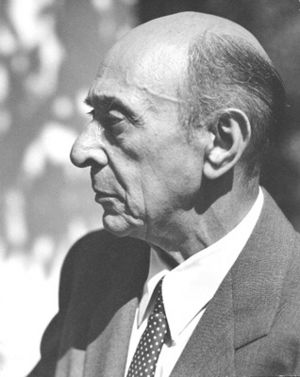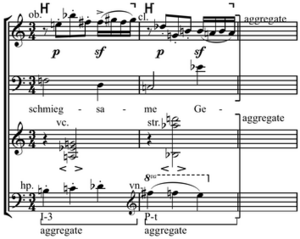Twelve-tone technique facts for kids
The twelve-tone technique is a special way to write music. It's also called dodecaphony or twelve-note composition. This method was first thought up by an Austrian composer named Josef Matthias Hauer in 1919.
Later, in 1923, another Austrian composer, Arnold Schoenberg (1874–1951), created his own, more famous version. This technique became very important for composers known as the "Second Viennese School".
The main idea is to make sure all 12 notes of the chromatic scale (all the notes on a piano, white and black, within one octave) are used equally. No single note is played more often or sounds more important than others. This is done using "tone rows," which are special orders of the 12 notes. Because all notes are equally important, the music doesn't sound like it's in a specific key.
Over time, this technique became very popular and influenced many composers in the 20th century. Even famous composers like Aaron Copland and Igor Stravinsky, who didn't use it at first, later started to include it in their music.
Schoenberg himself said it was a "Method of composing with twelve tones which are related only with one another." It's often seen as a type of serialism, where musical elements are put into a specific order.
Contents
How it Started and Who Used It
While many people think Arnold Schoenberg invented the twelve-tone technique in 1921, Josef Matthias Hauer actually published his "law of the twelve tones" in 1919. Hauer's idea was that all twelve chromatic notes must be played before any note is repeated.
For about twenty years, this method was mostly used by composers from the Second Viennese School. These included Alban Berg, Anton Webern, and Schoenberg himself.
Before the twelve-tone technique, composers wrote "freely" atonal music. This means the music didn't follow traditional key rules. Schoenberg developed the twelve-tone technique to give this "atonal" music a new structure. It helped replace the old rules of tonal music, where some notes were more important than others.
By the 1950s, the technique became very popular. Composers like Milton Babbitt, Luciano Berio, Pierre Boulez, and Igor Stravinsky started using it. Some even took the idea further, using the "serial" process to control not just pitches, but also how long notes lasted or how they were played. This led to what is called serial music.
Even American cartoon composer Scott Bradley, famous for music in Tom & Jerry and Droopy Dog, used the twelve-tone technique. He said it helped create the "out-of-this-world" sounds needed for cartoons. For example, in the Tom & Jerry short "Puttin' on the Dog", he used a chromatic scale to show tension as a mouse tries to sneak past dogs.
What is a Tone Row?
The main part of the twelve-tone technique is the tone row. This is an ordered list of all twelve notes of the chromatic scale. Think of it as a special musical alphabet for a piece.
Here are the main rules for creating a tone row:
- The row must be a specific order of all twelve notes of the chromatic scale. The octave (high or low version of a note) doesn't matter for the row itself.
- No note can be repeated within the row. Each of the 12 notes must appear exactly once.
- The row can be changed in special ways while keeping the same musical "distances" between notes. These changes are:
* Inversion (I): If a note goes up a certain distance, in the inversion it goes down that same distance. * Retrograde (R): The row is played backward. * Retrograde-inversion (RI): The inverted row is played backward.
- The row, in any of its four forms (original, inverted, retrograde, retrograde-inverted), can start on any of the twelve notes. This is called transposition. So, if the original row is P0, P1 means it's moved up one semitone (half step).
Each of these forms (Prime, Inversion, Retrograde, Retrograde-Inversion) can be started on any of the 12 notes. This means there can be up to 48 different versions of a single tone row! Some rows have fewer because some of their transposed forms might be the same.
Example of a Tone Row
Let's imagine a basic tone row (called the Prime form, P):
Now, let's see its transformations:
- Retrograde (R): This is the Prime form played backward.
:
- Inversion (I): The musical "steps" between notes are flipped. If the original goes up a step, the inversion goes down that same step.
:
- Retrograde Inversion (RI): This is the inverted row played backward.
:
Using Tone Rows in Music
The rules for tone rows apply to how the row itself is built. They don't mean that a composer can't repeat a note in the actual music until all twelve have been played.
Composers can use the row directly as a melody, or they can use it in more hidden ways to control the pitches. Even when used directly, the different forms of the row can be played one after another, at the same time, or overlapping. This helps create the harmonies in the music.
Composers can freely choose other parts of the music, like how long notes last (durations) or how loud they are (dynamics). However, some composers have created even more detailed systems where these elements are also controlled by rules (this is part of serialism).
Special Features of Tone Rows
The original tone row is called the prime series (P). There are many, many possible tone rows.
The main ways to change a prime series are:
- Transposition: Moving the whole row up or down to start on a different note.
- Retrograde (R): Playing the pitches in reverse order.
- Inversion (I): Flipping the direction of each musical interval.
These changes can be combined. For example, the retrograde inversion (RI) is the inverted row played backward.
Sometimes, parts of a tone row stay the same even after being transformed. This is called invariance. Composers like Anton Webern and Arnold Schoenberg used these "invariant" parts as musical "pivots" to connect different forms of the row.
Schoenberg's Way of Using It
Arnold Schoenberg used the twelve-tone technique in a very specific way. Here are some key features of his mature style:
- He often used Hexachords (groups of six notes) that could be inverted and still combine to form all 12 notes.
- He made sure all 12 notes were used in a complete group, called an aggregate.
- He presented the tone rows in clear melodic lines.
- He divided the row into smaller parts, like partitioning it.
- He used invariants, where certain groups of notes stayed the same even when the row was transformed.
- He created harmonies that fit with the tone row's properties.
- He used the pitch relationships to help create the rhythm and feel of the music.
Even though twelve-tone music is usually atonal (without a traditional key), some pieces, like those by Berg, can still have parts that sound tonal.
One of Schoenberg's most famous twelve-note pieces is Variations for Orchestra. The technique has also been used in funny ways, like in Leonard Bernstein's musical Candide, where a song about boredom uses the twelve-tone method. Benjamin Britten also used a twelve-tone row in his Cantata Academica to represent academic style.
Images for kids
See also
 In Spanish: Dodecafonismo para niños
In Spanish: Dodecafonismo para niños
- List of dodecaphonic and serial compositions
- All-interval twelve-tone row
- All-interval tetrachord
- All-trichord hexachord
- Pitch interval
- List of tone rows and series






